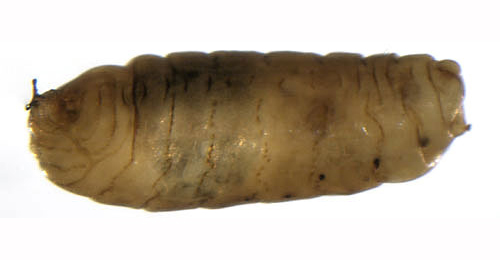|
||||||
|
ANTHOXANTHUM. Sweet Vernal-grass. [Poaceae] |
|
Two species of Anthoxanthum are recorded in Britain. These include the native Sweet Vernal-grass (A. odoratum). Seven British miners are recorded on Anthoxanthum. Nearly 100 British miners or possible miners are recorded on grasses in Britain. A key to the European miners recorded on Anthoxanthum is provided in Bladmineerders van Europa. It is recommended that adults of all miners on grasses be reared to be certain of their identity. |
Key for the identification of the known mines of British |
1a > Leaf-miner: Long, narrow, whitish mine. Pupation internal (Spencer, 1976: 453); anterior spiracles projecting through the epidermis. Whitish, upper-surface, rather narrow corridor with comparatively large frass grains that are laying further apart than their diameter. Pupation within the mine. The anterior spiracles of the orange-brown puparium penetrate the epidermis. |
 Chromatomyia nigra larva, lateral Image: © Willem Ellis (Bladmineerders van Europa) |
 Chromatomyia nigra pupa, lateral Image: © Willem Ellis (Bladmineerders van Europa) |
|
Chromatomyia nigra (Meigen, 1830) [Diptera: Agromyzidae]. |
| 1b > Leaf-miner: Narrow whitish mine, with frass in distinct black lumps. Pupation
internal (Spencer, 1976:
422).
Whitish, upper-surface, descending corridor, about halfway up the blade. Frass in distinct black grains that are lying further apart than their diameter. Pupation in the mine. |
|
Chromatomyia fuscula (Zetterstedt, 1838) [Diptera: Agromyzidae]. |
1c > Leaf-miner: Broad elongated mine; the form is dependent of the leaf form of the host plant. Frass green. Usually a number of larvae together in a mine. Pupation in the mine. |
|
Cerodontha incisa (Meigen, 1830) [Diptera: Agromyzidae]. |
1d > Leaf-miner: A narrow whitish linear mine, running down the leaf from the apex, with frass in two rows of separate grains. Pupation external (Spencer, 1976: 246). Narrow corridor from start to end, whitish, uppper- or lower-surface, genarally running downwards. Mine often along the leaf margin. Frass in distict grains of regular size, alternating along the sides of the corridor. Pupation outside the mine. |
 Mine of Liriomyza flaveola on Festuca gigantea Image: © Willis Ellis (Bladmineerders van Europa) |
|
Liriomyza flaveola (Fallén, 1823) [Diptera: Agromyzidae]. |
1e > Leaf-miner: Makes long narrow galleries. The frass is distributed through the mine and also some is ejected. The larvae may mine more than one leaf. Elongate, rather irregular blotch. Most frass is ejected, what remains is concentrated in a few heaps. The larva makes several mines. Pupaton outside the mine. |
|
Cosmopterix orichalcea Stainton, 1861 [Lepidoptera: Cosmopterigidae]. |
1f > Leaf-miner: In spring a short corridor is made that is almost stuffed with frass. After hibernation this mine is vacated, and the larva then makes a number of elongated blotches, all descending from the leaf tip. These latter mines are whitish, with irregularly scattered frass. |
|
Elachista humilis Zeller, 1850 [Lepidoptera: Elachistidae]. |
1g > Seed-feeder, leaf-miner and case-bearer: Initially it feeds on the seeds of thyme and then uses the seedhead as a case. It overwinters in this case and starts feeding again in March on grass spp. It then makes a case from the mined blade of grass. The larva initially feeds on the seeds of thyme, feeding within a floret and using this as its case. After overwintering, it changes foodplants to grass, and eventually forms an elongated case from two grass blade portions sewn together. The larva begins its life by eating out the ripe fruit of a thyme floret. The emptied and dried calyx functions as its first case, in which it hibernates. After hibernation the larva switches to grasses, initially in its original thyme case. Later a new case is made out of a mined grass leaf. This final case is about 11 mm long, two-valved, straw-coloured, has a mouth angle of 25°, and bears a striking resemblance to a grass spikelet. |
|
Coleophora lixella Zeller, 1849 [Lepidoptera: Coleophoridae] |
| Last updated 30-Jun-2019 Brian Pitkin | ||
